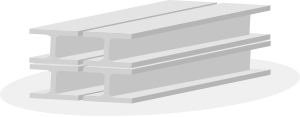3D printing materials
The 3D printing materials have come a long way since the early days of technology. At present there are many different materials, in different states (flour, fiber, pellets, plastic, etc.).
Depending on the industry, we provide the appropriate material (with the example of the dental industry) with more accurate material properties suitable for the application.
However, now there are too many exclusive materials from different 3D printer vendors to include the complete set. Instead, this article will look at the most common materials in a more general way. And there are also some outstanding materials
Plastic
Nylon, or Polyamide, often used in powder form crystalline or in the form of fibers with FDM process. It is a powerful, flexible and durable plastic that has proven its credibility with 3D printing. Natural white but can be dyed - before or after printing. This material can also be combined (powdered) with aluminum powder to create another common 3D printing material for crystallization - Alumide.
ABS is a common plastic used for 3D printing and is widely used on FDM 3D input fibrous printers. It is a particularly strong and colorful plastic. ABS can be purchased as a fiber from some non-originating source, which is another reason for its popularity.
PLA is a biodegradable biodegradable plastic material that has been tugged in 3D. It can be used in the plastic format for DLP / SL processes as well as in the form of fibers for FDM process. It is rich in color, including transparent, which is proven to be a useful option for some applications of 3D printing. However, it is not as durable or flexible as ABS.
LayWood is a 3D printing material developed specifically for 3D printers. It is fibrous and is a wood / polymer composite (also known as WPC).
Metal
An increasing number of metal and composite materials are used for the 3D printing industry. The two most common types are aluminum and cobalt derivatives.
One of the most powerful metals and therefore most commonly used for 3D printing is Stainless Steel Powder for Crystallization / Melting / EBM. It has a natural silver finish, but can be plated with other materials to create a gold or bronze effect
In the last few years, gold and silver have been added to metal materials that can be printed directly in 3D, with clear applications throughout the jewelery industry. These are very strong materials and are processed in powder form.
Titanium is one of the strongest metal materials and has been used for 3D printing applications. Provided as a powder, it can be used for crystallization / melting / EBM processes.
Ceramics
Ceramics are a relatively new set of materials that can be used for 3D printing with varying levels of success. It is particularly noteworthy for these materials that after printing, ceramic parts need to undergo the same process as any ceramic part that is made using traditional production methods - ie dried and glazed.
Paper
Standard A4 copier paper is a 3D printing material used by the proprietary SDL process provided by Mcor Technologies. The company operates a significantly different business model for other 3D print providers, with capital investment in the mid-range, but much emphasis on a viable source of material. Easily, cost-effectively and locally available. 3D prints are made of safe, environmentally friendly paper, easy to recycle and do not require any post-processing.
Food
Testing with extruders for 3D printing foods has increased dramatically over the past few years. Chocolate is the most popular. There are also printers working with sugar and some experiments with pasta and meat. Looking to the future, research is underway, using 3D printing technology to produce perfect meals.
Other
And finally, a company that has a unique (exclusive) supply of Stratasys, with digital materials for the Objet Connex 3D printing platform. This offer means that the standard Objet 3D printing materials can be incorporated in the printing process - at different concentrations and regimes - to create new materials with the required properties. It is possible to recognize up to 140 different digital materials from the combination of existing main materials in different ways.
Các tài liệu sẵn sàng trong chế độ 3D có có một cách dài khi ngày tháng của Công nghệ. There are now a variety of different types of materials, which are supplied in different states (powder, filament, pellets, granules, resin etc).
Specific materials are now generally developed for specific platforms đang thực hiện đang dùng công cụ (an example would be a dental sector) with material properties that more precisely suits the application.
However, there are now way too many proprietary materials from the very different 3D printer vendors to cover them all here. Instead, this article looks at the most popular types of media in a more generic way. Also a couple of materials that stand out.
Plastics
Nylon, or Polyamide, is commonly used in powder form with sintering process or in filament form with FDM process. It is a strong, flexible and durable plastic material that has proven solid for 3D printing. Nó in màu có thể màu i nhưng có thể được màu - pre- or post in. This material can also be combined (in powder format) with powdered aluminum to produce another common 3D printing material for sintering - Alumide.
ABS is another common plastic used for 3D printing, and is widely used on the entry-level FDM 3D printers in filament form. It is a very strong plastic and comes in a wide range of colors. ABS can be bought in filament form a number of non-propreitary sources, which is another reason why it is so popular.
PLA is a bio-degradable plastic material that has gained traction with 3D printing for this very reason. It can be utilized in resin format for DLP / SL processes as well as in filament form for FDM process. It is offered in a variety of colors, including transparent, which has proven to be a useful option for some applications of 3D printing. However it is not durable or as flexible as ABS.
LayWood is a 3D printing material for entry-level extrusion 3D printers. It comes in a filament form and is a wood / polymer composite (also referred to as WPC).

nhựa-in-3d
Metals
A growing number of metals and metal composites are used for industrial grade 3D printing. Two of the most common are aluminium and cobalt derivatives.
One of the strongest and therefore most commonly used metals for 3D printing is Stainless Steel in powder form for the sintering/melting/EBM processes. It is naturally silver, but can be plated with other materials to give a gold or bronze effect.
In the last couple of years Gold and Silver have been added to the range of metal materials that can be 3D printed directly, with obvious applications across the jewellery sector. These are both very strong materials and are processed in powder form.
Titanium is one of the strongest possible metal materials and has been used for 3D printing industrial applications for some time. Supplied in powder form, it can be used for the sintering/melting/EBM processes.

kim-loại-in-3d
Ceramics
Ceramics are a relatively new group of materials that can be used for 3D printing with various levels of success. The particular thing to note with these materials is that, post printing, the ceramic parts need to undergo the same processes as any ceramic part made using traditional methods of production — namely firing and glazing.

gốm-in-3d
Paper
Standard A4 copier paper is a 3D printing material employed by the proprietary SDL process supplied by Mcor Technologies. The company operates a notably different business model to other 3D printing vendors, whereby the capital outlay for the machine is in the mid-range, but the emphasis is very much on an easily obtainable, cost-effective material supply, that can be bought locally. 3D printed models made with paper are safe, environmentally friendly, easily recyclable and require no post-processing.

in-3d-giấy
Bio Materials
There is a huge amount of research being conducted into the potential of 3D printing bio materials for a host of medical (and other) applications. Living tissue is being investigated at a number of leading institutions with a view to developing applications that include printing human organs for transplant, as well as external tissues for replacement body parts. Other research in this area is focused on developing food stuffs — meat being the prime example.

in-3d-vật-liệu-sinh-học
Food
Experiments with extruders for 3D printing food substances has increased dramatically over the last couple of years. Chocolate is the most common (and desirable). There are also printers that work with sugar and some experiments with pasta and meat. Looking to the future, research is being undertaken, to utilize 3D printing technology to produce finely balanced whole meals.

in-3d-thức-ăn
Other
And finally, one company that does have a unique (proprietary) material offering is Stratasys, with its digital materials for the Objet Connex 3D printing platform. This offering means that standard Objet 3D printing materials can be combined during the printing process — in various and specified concentrations — to form new materials with the required properties. Up to 140 different Digital Materials can be realized from combining the existing primary materials in different ways.